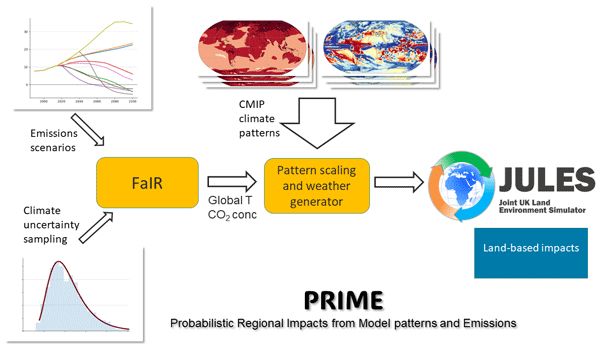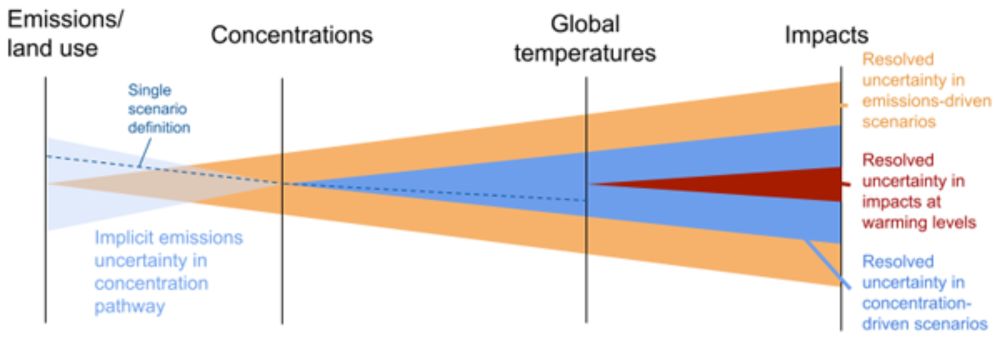Norman J. Steinert
@njsteinert.bsky.social
Want to get gridded temperature and precipitation responses to any future climate scenarios, including overshoot?
--> check out METEOR - a framework for emulating multi-timescale regional climate responses, with Marit Sandstad, Susanne Baur and @benmsanderson.bsky.social.
doi.org/10.5194/gmd-...
--> check out METEOR - a framework for emulating multi-timescale regional climate responses, with Marit Sandstad, Susanne Baur and @benmsanderson.bsky.social.
doi.org/10.5194/gmd-...

METEORv1.0.1: a novel framework for emulating multi-timescale regional climate responses
Abstract. Resolved spatial information for climate change projections is critical to any robust assessment of climate impacts and adaptation options. However, the range of spatially resolved future sc...
doi.org
November 6, 2025 at 1:28 PM
Want to get gridded temperature and precipitation responses to any future climate scenarios, including overshoot?
--> check out METEOR - a framework for emulating multi-timescale regional climate responses, with Marit Sandstad, Susanne Baur and @benmsanderson.bsky.social.
doi.org/10.5194/gmd-...
--> check out METEOR - a framework for emulating multi-timescale regional climate responses, with Marit Sandstad, Susanne Baur and @benmsanderson.bsky.social.
doi.org/10.5194/gmd-...
New paper out today with @benmsanderson.bsky.social, where we quantify the contriution of the permafrost carbon feedback to TCRE and ZEC under uncertainty.
Check it out here: doi.org/10.5194/esd-...
Check it out here: doi.org/10.5194/esd-...

Normalizing the permafrost carbon feedback contribution to the Transient Climate Response to Cumulative Carbon Emissions and the Zero Emissions Commitment
Abstract. As permafrost thaws, the permafrost carbon feedback (PCF) can amplify the Transient Climate Response to Cumulative Carbon Emissions (TCRE) and the Zero Emissions Commitment (ZEC) by introduc...
doi.org
October 15, 2025 at 1:26 PM
New paper out today with @benmsanderson.bsky.social, where we quantify the contriution of the permafrost carbon feedback to TCRE and ZEC under uncertainty.
Check it out here: doi.org/10.5194/esd-...
Check it out here: doi.org/10.5194/esd-...
OUT NOW: Global Tipping Points Report 2025
global-tipping-points.org
Our chapter on the "Implications of overshooting 1.5°C for
Earth system tipping points" is based on an associated paper: doi.org/10.31223/X52...
Minimizing climate overshoot is essential to prevent climate tipping points.
global-tipping-points.org
Our chapter on the "Implications of overshooting 1.5°C for
Earth system tipping points" is based on an associated paper: doi.org/10.31223/X52...
Minimizing climate overshoot is essential to prevent climate tipping points.

October 14, 2025 at 7:55 AM
OUT NOW: Global Tipping Points Report 2025
global-tipping-points.org
Our chapter on the "Implications of overshooting 1.5°C for
Earth system tipping points" is based on an associated paper: doi.org/10.31223/X52...
Minimizing climate overshoot is essential to prevent climate tipping points.
global-tipping-points.org
Our chapter on the "Implications of overshooting 1.5°C for
Earth system tipping points" is based on an associated paper: doi.org/10.31223/X52...
Minimizing climate overshoot is essential to prevent climate tipping points.
Reposted by Norman J. Steinert
Our finalised paper on flat10MIP is finally up in GMD! This is the experimental protocol which allows for a simple, emissions-driven evaluation of TCRE, ZEC and climate reversibility in CMIP7. Thanks so much to all who ran these simulations as a proof of concept! gmd.copernicus.org/articles/18/...

flat10MIP: an emissions-driven experiment to diagnose the climate response to positive, zero and negative CO2 emissions
Abstract. The proportionality between global mean temperature and cumulative emissions of CO2 predicted in Earth system models (ESMs) is the foundation of carbon budgeting frameworks. Deviations from ...
gmd.copernicus.org
September 8, 2025 at 9:56 AM
Our finalised paper on flat10MIP is finally up in GMD! This is the experimental protocol which allows for a simple, emissions-driven evaluation of TCRE, ZEC and climate reversibility in CMIP7. Thanks so much to all who ran these simulations as a proof of concept! gmd.copernicus.org/articles/18/...
Reposted by Norman J. Steinert
flat10-MIP has landed! gmd.copernicus.org/articles/18/...

flat10MIP: an emissions-driven experiment to diagnose the climate response to positive, zero and negative CO2 emissions
Abstract. The proportionality between global mean temperature and cumulative emissions of CO2 predicted in Earth system models (ESMs) is the foundation of carbon budgeting frameworks. Deviations from ...
gmd.copernicus.org
September 5, 2025 at 8:30 AM
flat10-MIP has landed! gmd.copernicus.org/articles/18/...
Reposted by Norman J. Steinert
Very cool that @carbonbrief.org @ayeshatandon.carbonbrief.org have covered our study, take a read here!
NEW – ‘Significant’ risk of Amazon forest dieback if global warming overshoots 1.5C | @ayeshatandon.carbonbrief.org w/ comment from @gergmunday.bsky.social Nico Wunderling @davidamckay.bsky.social David Lapola @chrisd-jones.bsky.social

‘Significant’ risk of Amazon forest dieback if global warming overshoots 1.5C - Carbon Brief
Even passing 1.5C of global warming temporarily would trigger a “significant” risk of Amazon forest “dieback”, says a new study.
buff.ly
May 16, 2025 at 9:58 AM
Very cool that @carbonbrief.org @ayeshatandon.carbonbrief.org have covered our study, take a read here!
New paper out today!
Irreversible hydrological changes on land after temperature overshoot affect land water availability for over 23% of the world population in 12% of the global land area, covering regions of various hydrological regimes.
doi.org/10.1029/2024...
Irreversible hydrological changes on land after temperature overshoot affect land water availability for over 23% of the world population in 12% of the global land area, covering regions of various hydrological regimes.
doi.org/10.1029/2024...

Irreversible Land Water Availability Changes From a Potential ITCZ Shift During Temperature Overshoot
A strong intertropical convergence zone (ITCZ) shift occurs in 1–2 of 8 CMIP6 models simulating overshoot, not depicting the most likely but a plausible high-impact outcome The ITCZ shift drives ...
doi.org
May 14, 2025 at 2:28 PM
New paper out today!
Irreversible hydrological changes on land after temperature overshoot affect land water availability for over 23% of the world population in 12% of the global land area, covering regions of various hydrological regimes.
doi.org/10.1029/2024...
Irreversible hydrological changes on land after temperature overshoot affect land water availability for over 23% of the world population in 12% of the global land area, covering regions of various hydrological regimes.
doi.org/10.1029/2024...
Reposted by Norman J. Steinert
New paper on the risks of forest ecosystem impacts under emissions pathways designed to meet the Paris Agreement temperature goals is out today in Nature Climate Change! 🌳
Read it here: www.nature.com/articles/s41558-025-02327-9
Read it here: www.nature.com/articles/s41558-025-02327-9
www.nature.com
May 12, 2025 at 9:14 AM
New paper on the risks of forest ecosystem impacts under emissions pathways designed to meet the Paris Agreement temperature goals is out today in Nature Climate Change! 🌳
Read it here: www.nature.com/articles/s41558-025-02327-9
Read it here: www.nature.com/articles/s41558-025-02327-9
New paper! Incorporating plant and soil data reveals hidden agricultural drought stress areas and shows that, despite increasing extremes, future agricultural drought stress may decrease in some regions thanks to increasing soil moisture.
iopscience.iop.org/article/10.1...
iopscience.iop.org/article/10.1...
Radware Bot Manager Captcha
To ensure we keep this website safe, please can you confirm you are a human by ticking the box below.
iopscience.iop.org
May 1, 2025 at 9:09 AM
New paper! Incorporating plant and soil data reveals hidden agricultural drought stress areas and shows that, despite increasing extremes, future agricultural drought stress may decrease in some regions thanks to increasing soil moisture.
iopscience.iop.org/article/10.1...
iopscience.iop.org/article/10.1...
Reposted by Norman J. Steinert
Our new open access paper on the PRIME Earth System emulator for estimating regional impacts is out now: gmd.copernicus.org/articles/18/..., @njsteinert.bsky.social, @chrisd-jones .bsky.social, @cjsmith.be, @gergmunday.bsky.social, @dougmcneall.bsky.social

A rapid-application emissions-to-impacts tool for scenario assessment: Probabilistic Regional Impacts from Model patterns and Emissions (PRIME)
Abstract. Climate policies evolve quickly, and new scenarios designed around these policies are used to illustrate how they impact global mean temperatures using simple climate models (or climate emul...
gmd.copernicus.org
March 17, 2025 at 10:25 AM
Our new open access paper on the PRIME Earth System emulator for estimating regional impacts is out now: gmd.copernicus.org/articles/18/..., @njsteinert.bsky.social, @chrisd-jones .bsky.social, @cjsmith.be, @gergmunday.bsky.social, @dougmcneall.bsky.social
New paper on “Continued permafrost ecosystem carbon loss under net-zero and negative emissions” due to irreversibility of inundated areas, which could delay or hinder climate change mitigation efforts.
www.science.org/doi/10.1126/...
www.science.org/doi/10.1126/...

Continued permafrost ecosystem carbon loss under net-zero and negative emissions
Permafrost ecosystem carbon loss may continue under net-zero and negative emissions, hindering climate mitigation efforts.
www.science.org
February 14, 2025 at 9:37 AM
New paper on “Continued permafrost ecosystem carbon loss under net-zero and negative emissions” due to irreversibility of inundated areas, which could delay or hinder climate change mitigation efforts.
www.science.org/doi/10.1126/...
www.science.org/doi/10.1126/...
Reposted by Norman J. Steinert
It's January, which means the EGU abstract Submission deadline is fast approaching: Jan 15th!
So if you're in the net-zero world please take a look at: Towards net zero and beyond: remaining carbon budgets, negative emissions, mitigation pathways and implications for policy
So if you're in the net-zero world please take a look at: Towards net zero and beyond: remaining carbon budgets, negative emissions, mitigation pathways and implications for policy
January 3, 2025 at 4:11 PM
It's January, which means the EGU abstract Submission deadline is fast approaching: Jan 15th!
So if you're in the net-zero world please take a look at: Towards net zero and beyond: remaining carbon budgets, negative emissions, mitigation pathways and implications for policy
So if you're in the net-zero world please take a look at: Towards net zero and beyond: remaining carbon budgets, negative emissions, mitigation pathways and implications for policy
Reposted by Norman J. Steinert
Main takeaway from this (excellent) meeting: ZEC is not a singular property of the climate system. It's a catch-all for everything which isn't described by TCRE - and the more we study it, the more exotic and confusing it seems to be.
Joined a fantastically interesting workshop on TCRE and ZEC last night If you have ideas on the assessment and definition of TCRE or ZEC (including on whether ZEC is even a useful/real concept) submit to this EGU session! 👇 1/2
December 17, 2024 at 6:50 PM
Main takeaway from this (excellent) meeting: ZEC is not a singular property of the climate system. It's a catch-all for everything which isn't described by TCRE - and the more we study it, the more exotic and confusing it seems to be.
Reposted by Norman J. Steinert
#EGU25 session announcement!
Physical and statistical emulators for climate impacts
with @rebeccamayvarney.bsky.social, @yannquilcaille.bsky.social, Greg Munday & Norman Steinert
meetingorganizer.copernicus.org/EGU25/sessio...
Physical and statistical emulators for climate impacts
with @rebeccamayvarney.bsky.social, @yannquilcaille.bsky.social, Greg Munday & Norman Steinert
meetingorganizer.copernicus.org/EGU25/sessio...

November 18, 2024 at 10:41 PM
#EGU25 session announcement!
Physical and statistical emulators for climate impacts
with @rebeccamayvarney.bsky.social, @yannquilcaille.bsky.social, Greg Munday & Norman Steinert
meetingorganizer.copernicus.org/EGU25/sessio...
Physical and statistical emulators for climate impacts
with @rebeccamayvarney.bsky.social, @yannquilcaille.bsky.social, Greg Munday & Norman Steinert
meetingorganizer.copernicus.org/EGU25/sessio...
Reposted by Norman J. Steinert
New paper on #CMIP7 emissions-driven design out today in GMD.
Earth System Modeling has long relied on simulations driven by GHG concentrations. But this approach is outdated.
ESMs need to resolve human activity and its consquences.
gmd.copernicus.org/articles/17/...
Earth System Modeling has long relied on simulations driven by GHG concentrations. But this approach is outdated.
ESMs need to resolve human activity and its consquences.
gmd.copernicus.org/articles/17/...

The need for carbon-emissions-driven climate projections in CMIP7
Abstract. Previous phases of the Coupled Model Intercomparison Project (CMIP) have primarily focused on simulations driven by atmospheric concentrations of greenhouse gases (GHGs), for both idealized ...
gmd.copernicus.org
November 19, 2024 at 2:00 PM
New paper on #CMIP7 emissions-driven design out today in GMD.
Earth System Modeling has long relied on simulations driven by GHG concentrations. But this approach is outdated.
ESMs need to resolve human activity and its consquences.
gmd.copernicus.org/articles/17/...
Earth System Modeling has long relied on simulations driven by GHG concentrations. But this approach is outdated.
ESMs need to resolve human activity and its consquences.
gmd.copernicus.org/articles/17/...

